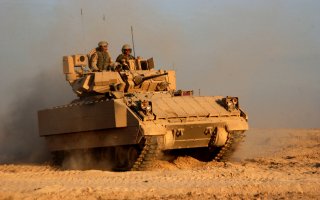The Heavy Infantry Fighting Vehicle: An Emerging Weapon Of War
IFVs are mounting bigger and bigger guns and packing on more and more armor.
Here's What You Need to Know: The tactical mobility and speed advantages that originally characterized the IFV no longer apply to these new vehicles.
Designing an armored vehicle always involves a three way compromise called the Iron Triangle between protection, mobility and firepower. Infantry Fighting Vehicles (IFVs) have traditionally been focused on mobility and firepower, with less emphasis on protection. But recent trends in conflicts have started to change this, as IFVs are mounting bigger and bigger guns and packing on more and more armor. A new class of vehicle is emerging: the heavy IFV.
The first IFVs were significantly more mobile than most main battle tanks (MBTs) in their era. In contrast to the T-55 and T-62, the BMP-1 could float across rivers and move faster on and off road. But the designers didn’t neglect the “fighting” aspect either, as it was meant to be able to tackle most MBTs of the era in ambush with its Malyutka Anti-Tank Guided Missile (ATGM). The American M2 Bradley also was amphibious and could handle tanks with its TOW ATGM.
The big trade-off they made was that they were not well armored at all. Bullets from a .50 caliber machine gun could go through the side a BMP-1 like butter and while the front was more resistant, almost any tank gun would go through it.
As the primary task of these vehicles was to support the infantry, this level of armor was considered acceptable. The mobility and firepower of the vehicle was considered to be more important because these early IFVs were designed to fight in a mechanized Cold War battlefield.
The key roles of the IFV were to provide Nuclear, Biological, and Chemical protection to the troops, protect them from small arms and artillery and bring a larger punch to the battlefield than what the infantry themselves could carry.
Adding more armor wouldn’t make them that much more effective at their role, and it would compromise their tactical mobility by getting rid of their quick-fording and swimming aspects. Soviet doctrine emphasized this capability: when crossing a water obstacle the BMPs were meant to cross first and secure the opposite shore before the tanks would attempt to snorkel or be ferried over.
As the 1980s came around, the Soviet BMP series first saw combat. The thin armor initially meant for Cold War mechanized warfare proved too thin. As a result, the Soviets chose to sacrifice the river crossing ability and some speed in exchange for more armor in the D variants of the BMP-1 and BMP-2.
The D did not fully replace the regular BMP-2 variants, and the next BMP, the BMP-3 still retained the amphibious capability. Still, the trend foreshadowed what might happen in the future with IFVs.
In 1988, the US also sacrificed the river crossing ability of the Bradley in the M2A2 version. Additional armor was added to the side to protect against heavier caliber ammunition and shrapnel. Unlike the Soviets, further versions of the Bradley didn’t restore the amphibious capability.
Instead, American designers tacked on more and more armor and equipment onto the Bradley. The original Bradley weighted around twenty-seven tons; by the M2A3 variant the Bradley weighted thirty-two tons with additional explosive reactive armor.
The increase in armor was not just an American and Soviet thing. The Germans also began to get interested in heavier designs. Around the end of the Cold War, the Federal Republic of Germany planned to replace their Marder 1 IFVs with the Marder 2. This beast of an IFV had enough armor to stop a tank round and weighed forty-three tons, more than the first T-72s. It also packed a thirty-five millimeter cannon that was far more powerful than any other IFV cannon of the era.
This trend of ever increasing cannon and armor weights for IFVs has continued to the present day, where Russia is considering making an IFV version of the Armata with the T-15. Germany has also continued the legacy of the Marder 2 with the slightly-less-armored but still heavy Puma IFV.
But what’s driving these trends for these heavier and heavier IFVs? The tactical mobility and speed advantages that originally characterized the IFV no longer apply to these new vehicles, as they lumber along at the same speed as tanks and aren’t amphibious.
One possible reason is an arms versus armor race with IFVs. IFVs are often expected to fight other IFVs, so the weight of the armor on them has gone up as the caliber of IFV weapons has increased. The current M2A3 Bradley is protected against the BMP-2’s thirty millimeter cannon on the frontal arc, while the original M2 Bradley was only protected against a BTR’s 14.5mm heavy machine gun.
Another possible reason is a shift towards COIN. In COIN mitigating casualties is more important than speed or tactical mobility, so there’s a high incentive to armor up existing platforms. While IFVs were originally designed to fight infantry from outside of the range of shoulder launched AT weapons like the RPG, COIN can push them into those tight engagements with infantry so armor is becoming more important. The overall downsizing of militaries also makes it cheaper to procure such heavy (and expensive) IFVs, as most militaries no longer need to field multiple divisions worth of them.
Information on BMP tactics taken from The British Army Field Manual Volume 2 Part 3: Soviet Tactics.
Charlie Gao studied Political and Computer Science at Grinnell College and is a frequent commentator on defense and national-security issues.
This article first appeared in 2018.
Image: U.S. Army

